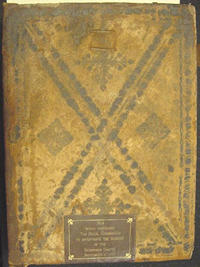Gaspee
Days Committee History
Files History
Files |
| The Box That Held the Gaspee Commission & Its Restoration |
|
 The
top (left) and inside (right) of the Gaspee
Commission
Box. The inside of the box is interestingly lined with pages of
an
old book on Roman history, then printed over with a pattern. It
appears that they made good use of
recycling even in the days of King George III. Photos taken May
2001
at the Presentation of Gaspee Artifacts, Warwick Public Library.
Many thanks to Gwen Stern of the RI Archives for making this historic
item
available for our viewing. The
top (left) and inside (right) of the Gaspee
Commission
Box. The inside of the box is interestingly lined with pages of
an
old book on Roman history, then printed over with a pattern. It
appears that they made good use of
recycling even in the days of King George III. Photos taken May
2001
at the Presentation of Gaspee Artifacts, Warwick Public Library.
Many thanks to Gwen Stern of the RI Archives for making this historic
item
available for our viewing.
|
| Read New York Times article describing
the Commission Box
(.pdf) |
|
The Restoration of the Box That Held
the Gaspee Commission
Quite like a fairy tale this seem, for we invite you to a white marble palace, built on one of the seven hills of a city by the sea. This opens only to the touch of the initiated, the door swings slowly back, a red velvet hanging is parted, and we see, placed against the wall, a framed parchment, yellowed with age. This parchment bears a royal insignia, and our interest deepens when we see inscribed the word Gaspee. This white marble building, with its famous dome, is none other than our State Capitol, designed by McKim, Mead & White, of New York. The iron door is a part of the safe that protects the archives of the State of Rhode Island, with the Secretary of State as custodian. The Royal document, so carefully protected, is known as the Gaspee Commission, sent by George III to Joseph Wanton, the third governor of Rhode Island, demanding an investigation of the capture and burning of the British schooner Gaspee, and offering a reward for the conviction of the culprits. We know well the result of this investigation.Captain Thomas Swan of Bristol, the Revolutionary ancestor of the writer, and one who participated in the burning of the Gaspee, in 1772, wrote: "This did provoke the king so high,The committee of investigation met in Newport and in Providence and after nine months, on June 22, 1775, sent a report "To the King's Most Excellent Majesty", that no one could, be found who knew, saw, or remembered anything concerning the burning of the British schooner Gaspee. <>This Gaspee Commission, so called, sent over the high seas in the days of sailing vessels, was encased in a leather covered, wooden box. This historic box plainly showed the ravages of time, the sides were broken, the cover was off, and the hand-tooled leather dulled with age. The fact that there was such an historic box, and of its condition, was brought to the attention of our State Regent, by John W. Haley, "The Rhode Island Historian." Mrs. McCrillis in turn commissioned the Regent and Historian of Gaspee Chapter to investigate and see what could be done toward the restoration and preservation of this historic box.
In April 1937, after an interesting and satisfactory visit to the State House, a letter was received from the Secretary of State, expressing thanks that the condition of this historic box had been brought to their attention, and stating that restoration would be attended to in the near future. On January 8, 1938 word was received that this work had been completed. As chairman of this committee appointed by Mrs. McCrillis, I have the honor to report that this historic box, with the sides deftly mended, the cover replaced, now bears a plate on which is inscribed - "Box which contained the Royal Commission to investigate the burning of the Schooner Gaspee, dated Sept. 21, 1772". This restored box still shows the wax where the royal seal was broken when, over 165 years ago, the rolled parchment was removed from the box. This restored, historic box is now in the fireproof vault of the Division of Archives, of the Department of State, together with the famous Gaspee Commission it once protected. It is gratifying to place on record these facts, not only intimately connected with Gaspee Chapter, but vital facts concerning the early history of our state and the founding of this nation. |
| Back to Top | Back to Gaspee Days Committee History files | Back to Gaspee Virtual Archives |
